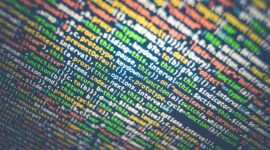During the processing of residues, these elements might come in contact with workers, be released to the environment or end up in the final product that will expose consumers, explained Andrei Goronovski, PhD student at the Institute of Physics, University of Tartu (UT). He added that natural radionuclides are examples of such trace elements—they are widespread in the environment but might accumulate in the residues during raw material processing.
This is why research groups at the University of Tartu (headed by Alan Tkaczyk) and KTH Royal Institute of Technology (headed by Anna Björklund) are interested in considering the impact of Naturally Occurring Radioactive Materials (NORM) within the Life Cycle Assessment (LCA) methodology. Their article will soon be published in The International Journal of Life Cycle Assessment[1]. All this work is part of the Marie Skłodowska-Curie REDMUD project[2][3].
Peter James Joyce, PhD student at KTH Royal Institute of Technology and former visiting PhD student at UT, said that that a current challenge within LCA is how to best account for the ionising radiation impact caused by NORM. There is no comprehensive method to do this, so current LCA studies may not fully consider these aspects. This is where the research of the aforementioned UT and KTH research groups comes in: “We have developed a framework setting out how it can be included in LCA studies, and created a set of factors so all LCA practitioners can put our method into practice in their studies. There’s a common saying that ‘you can’t manage what you can’t measure’. Our new method allows the magnitude of these impacts to be measured and therefore managed— for example, by changing the design of your products or by using them for different applications,” he explained.

Surprising Results
According to Joyce, NORM radionuclides are found naturally in common building materials, like bricks and concrete, and when we think about the impact caused by these products, we tend to think about their production—e.g., extracting raw materials and causing pollution, burning fuels when firing bricks or clinker and releasing toxins, particles and greenhouse gases. “But it turns out that in terms of human health, when you produce a kilogram of bricks or concrete, the biggest impact comes from the ionising radiation from the very low levels of NORM that people are exposed to when they live in houses built from this material, not from the nasty stuff that’s emitted during their production. There’s no need to be alarmed though! The impact is still very low,” he said.
Goronovski indicated that it was surprising to find out how even though the natural sources of radiation are far more significant than artificial sources in terms of exposure to average persons, these natural sources have not drawn adequate attention in the past. “For instance, in LCA, there have been attempts to implement an impact category of ionising radiation, modelling exposure from artificial radionuclides produced at nuclear plants,” he said. In the article, they show that exposure to people from natural sources of radiation is ~100–200 times larger than from nuclear power applications, and should be accounted for in the LCA methodology.
Developing New Smart Materials
Joyce said that the next step of their research is to publish the characterisation factors they have developed, and the model they have created to develop them, so that other researchers can use them. “We’re also working with other researchers as part of the REDMUD project who are developing new materials (including inorganic polymers and new types of iron-rich cements) to help them manage and reduce the environmental impact of their materials, including the impact of NORM,” he said.
Goronovski added that the REDMUD team aims to find a solution to the Bauxite Residue problem (BR). BR is a by-product of the aluminium industry, produced in millions of tons worldwide. It is a promising secondary raw material for metal and construction industries. “Our role at UT is to assess the radiological aspects of different BR processing techniques developed within the REDMUD project, so the described NORM-LCA method is a tool that would allow to evaluate and compare different processes regarding natural radiation, and help optimize the processes, considering environmental and human health concerns,” he explained.
[1] Article by Joyce, P. J.; Goronovski, A.; Tkaczyk, A. H.; Björklund A. A framework for including enhanced exposure to naturally occurring radioactive materials (NORM) in LCA. Accessible here: https://link.springer.com/article/10.1007%2Fs11367-016-1218-2
[2] REDMUD is a project funded by the European Union and coordinated by KU Leuven. The official web page of the project is: http://etn.redmud.org/. More additional information is available here: http://ec.europa.eu/research/infocentre/article_en.cfm?artid=44436.
[3] The research leading to these results has received funding from the European Community’s Horizon 2020 Programme ([H2020/2014–2019]) under Grant Agreement No. 636876 (MSCA-ETN REDMUD).
This article was funded by the European Regional Development Fund through Estonian Research Council.
 Back
Back


